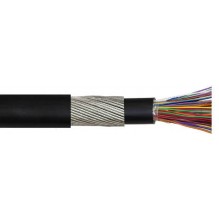
British telecom specification CW1198 covers a range of external grade cable with a galvanise steel wire armour gel filled suitable for direct burial.

British telecom specification CW1198 covers a range of external grade cable with a galvanise steel wire armour gel filled suitable for direct burial.
Application
The cable is designed primarily for direct burial in the ‘D’ or Secondary side of local telecommunications networks. The cable core comprises units of cellular polyethylene insulated twin conductors flooded with petroleum jelly and wrapped with a paper tape. The cable core is then covered with a black polyethylene inner sheath. A layer of galvanised steel armour wires is then applied over the inner sheathed cable and an outer sheath of PE is applied over the armour wires. Compliant with BT Specification CW1198). The product is also available with a PVC outer sheath in lieu of polyethylene and with filling compound suitable for tropical climates with a drop point greater than 80ºC.
Construction
Available as twisted pairs in 10 Pair Units with range from 2 to 100.
Product Description
Plain annealed solid copper wire, cellular polyethylene insulation, twisted pairs, petroleum jelly filling, paper core wrap, moisture barrier bonded to black low-density polyethylene sheath. The armour is used as additional protection of telecommunication cables for direct burial. The jelly filled or air core cable is armoured with a suitable number of galvanised mild steel wires applied directly over the polyethylene sheath of the cable. The wires shall comply with BS EN 10257 Part 1 except that the tensile strength shall be not less than 340 MN/m2 and not greater than 540 MN/m2. The value of resistivity for the armour is not mandatory. The cable is then sheathed overall with PE or polyethylene.
Insulation Resistance
Insulation resistance measurements shall be made with not less than 500 volts D.C. After steady electrification for one minute the insulation resistance measured between each conductor and the remaining conductors connected together shall be not less than 1500 megohms per 1000 metres at 20°C.
Capacitance Unbalance
Not more than 1% of the corrected capacitance unbalance measurements between adjacent pairs shall exceed the following values:
Two-Pair (Quad) Cable 800pF. All other sizes 275pF.

